Introduction The gut system’s primary function is to make sure that the consumed food that a person eats is digested in the stomach, and the intestines (both…


Introduction The gut system’s primary function is to make sure that the consumed food that a person eats is digested in the stomach, and the intestines (both…

Introduction When a person consumes food, it is traveled down to the gut system, where it can be digested and biotransformed into nutrients in the small…

Introduction The gut system is home to the organs and intestines that ensure that the consumed food is digested and absorbed into the bloodstream while being transported…

Introduction Inside the body, the gut and the intestines make sure that everything is working properly. The gut and intestinal system make sure that the…

Introduction The gut system makes sure that any food that is being digested gets turned into nutrient particles and is transported all over the entire body. The…

Introduction The body requires the gut and the intestines (both small and large) to store, digest, and transport the nutrients from food to all the body’s organs, tissues, muscles,…

Introduction The body’s primary job is to make sure that each organ system works correctly and does its job. One of the systems in the…

Introduction The gut system is where food is being consumed and digested in the gastrointestinal (GI) tract and excreted out of the body. The acids…

Introduction In the body, the digestive system makes sure that the food that is being consumed is digested in the gastrointestinal (GI) tract and the…

Introduction Part of the digestive system’s primary system is to make sure that the food that a person is consuming is being digested and excreted…

Introduction The digestive system is home to the gut, the gastrointestinal (GI) tract, the liver, the intestines, and other organs that make sure that the…

Introduction The digestive system is home to the gastrointestinal (GI) tract where food is being digested and being transformed into nutrients for the body to…

Introduction The gastrointestinal tract is part of the digestive system and its primary job is to make sure that the food is being consumed and…

Introduction The gut and the brain have two different jobs that do different functions in the body but, have a bidirectional communication with each other.…

Introduction The gut system makes sure that the good bacteria is helping the gut by digesting the consumed food into nutrients for the body and…

Introduction The gut system’s main function is to digest food to be turned into nutrients in the body and excrete the waste out of the…

Introduction The gut is home to many bacterias that help out the body by digesting the food that a person eats, and excretes the waste…